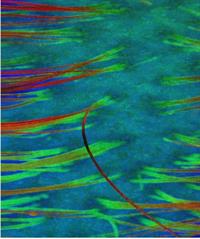Study shows optical coherence tomography with artificial intelligence methods can accurately and efficiently monitor hair growth therapies.
 Wausau, WI (October 15, 2020) – One of the challenges in developing effective hair loss therapies is the lack of reliable non-invasive methods to monitor treatment response or alopecia progression. This study proposes the use of optical coherence tomography (OCT) and automated deep learning to non-invasively evaluate hair and follicle counts that may be used to monitor the success of hair growth therapy more accurately and efficiently.
Wausau, WI (October 15, 2020) – One of the challenges in developing effective hair loss therapies is the lack of reliable non-invasive methods to monitor treatment response or alopecia progression. This study proposes the use of optical coherence tomography (OCT) and automated deep learning to non-invasively evaluate hair and follicle counts that may be used to monitor the success of hair growth therapy more accurately and efficiently.
This report, published in Lasers in Surgery and Medicine (LSM), the official journal of the American Society for Laser Medicine and Surgery, Inc. (ASLMS), was selected as the October 2020 Editor’s Choice.
The study, conducted by a team from the University of California, Irvine, is titled “Combining Deep Learning with Optical Coherence Tomography Imaging to Determine Scalp Hair and Follicle Counts”.
“Hair loss often causes emotional trauma, and current hair growth treatment evaluation methods are all invasive to some degree, furthering that trauma. We wanted to develop a method that is no worse than simply taking a picture,” said Gregor Urban, MS.
Optical coherence tomography can be used as a completely non-invasive method for evaluating the effectiveness of hair growth therapies, unlike currently used methods, which are all invasive to certain degrees. Given that the three-dimensional imaging data from the OCT device is very labor intense to evaluate manually, artificial intelligence methods can be used to identify and count all hairs and follicles in the scans automatically and rapidly.
The proposed method is evaluated on a total of 70 different OCT scans and found the automated deep learning system's accuracy to be similar to human evaluators but significantly faster. This approach is thus well positioned to become a standard for non-invasive evaluation of hair growth treatment progress in patients, saving significant amounts of time and effort compared to manual evaluation.
The research was carried out at the University of California, Irvine by an interdisciplinary and diverse team including computer science and machine learning experts (Prof. Pierre Baldi and PhD student Gregor Urban), and dermatology physicians led by Prof. Natasha Mesinkovska, MD Chloe Ekelem, and later by Nate Feil. They were crucially supported by medical students Ella Csuka and Kiana Hashemi and MD resident Franchesca Choi.
Editor’s Choice is an exclusive article published in LSM, the official journal of the ASLMS. View the complete manuscript.
The American Society for Laser Medicine and Surgery, Inc. (ASLMS) is the largest multidisciplinary professional organization dedicated to the development and application of lasers and related technology for health care applications. ASLMS promotes excellence in patient care by advancing biomedical application of lasers and other related technologies worldwide. ASLMS membership includes physicians, surgeons, nurses and allied health professionals representing multiple specialties, physicists involved in product development, biomedical engineers, biologists, industry representatives and manufacturers. For more information, visit aslms.org.